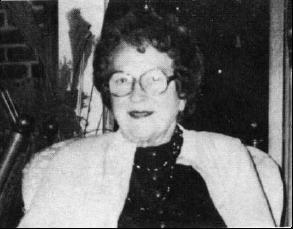National Cambridge Collectors, Inc.
A non-profit 501(c)(3) organization.

Worker of the Month: Olga Berilla
by Sharon Miller - Issue #241 - May 1993
The Cambridge Cordials' Worker of the Month is Olga Berilla of Byesville, Ohio. Mrs. Berilla began work at the Cambridge Glass House 50 years ago in January 1943. She worked there during World War II and was first assigned a government contract job making medicinal beakers. The beakers ranged in size from 10ml to 1 liter. They were shipped to Veterans Hospitals all over the United States.
 Mrs. Berilla shared several
interesting facts about her work in this specialized department.
Her job was to put calibration lines on the smallest of the
beakers. When she received her beakers, they were completely
covered with wax. Using a table top tool with a needle attached,
she made lines through the wax to allow for etching of the ware.
Some calibration lines went all the way around the beaker while
others were shorter and only on one side.
Mrs. Berilla shared several
interesting facts about her work in this specialized department.
Her job was to put calibration lines on the smallest of the
beakers. When she received her beakers, they were completely
covered with wax. Using a table top tool with a needle attached,
she made lines through the wax to allow for etching of the ware.
Some calibration lines went all the way around the beaker while
others were shorter and only on one side.
Other workers in the department were resposible for putting on the numbers and calibrating the beakers. The calibrators worked in pairs. They added water, a drop or two at a time, and then painted dots to show placement of the line. Accuracy was very important as the beakers were used to dispense medicines. Mrs. Berilla said that one had to be careful not to press too hard with the needle or the beaker would break; however too little pressure would not allow for a good etch. All of her work the first week was discarded. This was the standard procedure for new workers because of the accuracy and quality wanted. Mrs. Berilla's output for the first week was 3 dozen beakers. Later, she could put out 10 dozen per day.
Mrs. Berilla received her first paycheck on January 8, 1943, for $13.76. The cost to ride the bus to Cambridge was about $1.00 per week. Her paycheck was usually around $18.00 per week. John Hydock was the foreman of this specialized department nd it was located next to the etching department. The beaker that Mrs. Berilla shared with the group was a pressed piece with a small round foot and a slightly flared top. The Triangle C ws etched on the cup portion of the beaker. The beakers were only made in crystal.
Following completion of the government contract that lasted about a year, Mrs. Berilla was reassigned to the selecting department, where she wshed and wrapped the ware for shipment. She recalled that there would be times when there were many tables of ware that had been removed from the lehr waiting to be sorted into orders. She said that the workers were always kept quite busy. The selectors would place the ware on a metal table to better see any imperfections in shape and color. She also said that the blowers would come back to the selecting department several times each day to see the results of their work. Their pay was affected by the quality of ware they turned out.
Mrs. Berilla shared an incident with the group that occurred when she, and another lady who also had been transferred to the selecting department, continued to be paid $0.49 per hour. The wage in this department was $0.46 per hour. When the other workers in the selecting department found out about the wage difference, they threatened to stage a work stoppage. Mrs. Berilla said that the foreman, Nye McHenry, came to the two of them and said they would have to accept a wage cut or they would lose their jobs. They agreed to the cut and there was no more trouble. Sometimes it was necessary to work on Saturdays to get out an order. She could not remember if the workers were paid a higher wage for Saturday work.
Mrs. Berilla recalled that Cambridge made much crystal ware during the War years. She also remembered moonlight blue, a lot of amber, yellow and light green ware. Reds were not made because of the War. She sid that one piece that was often rejected by the selectors was the lid for the three compartment candy dish. A good fit was difficult to achieve and sometimes a whole batch would have to be discarded. During her time in the selecting department, Mrs. Berilla fondly recalled that she had the privilege of handling some very beautiful pieces of Cambridge ware. It is obvious that she still appreciates the fragile beauty of Cambridge glass.